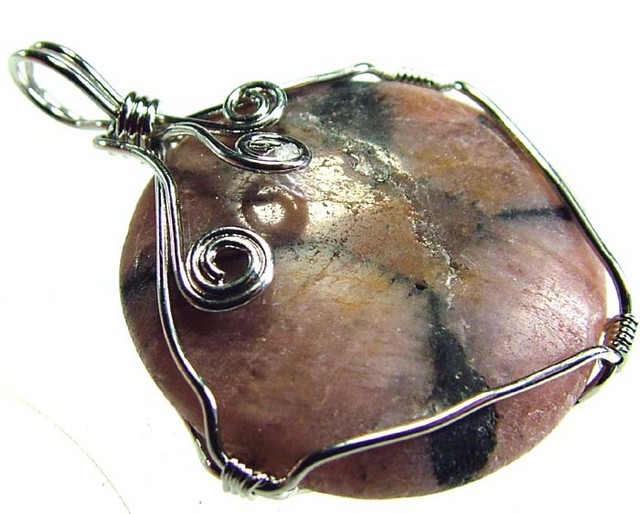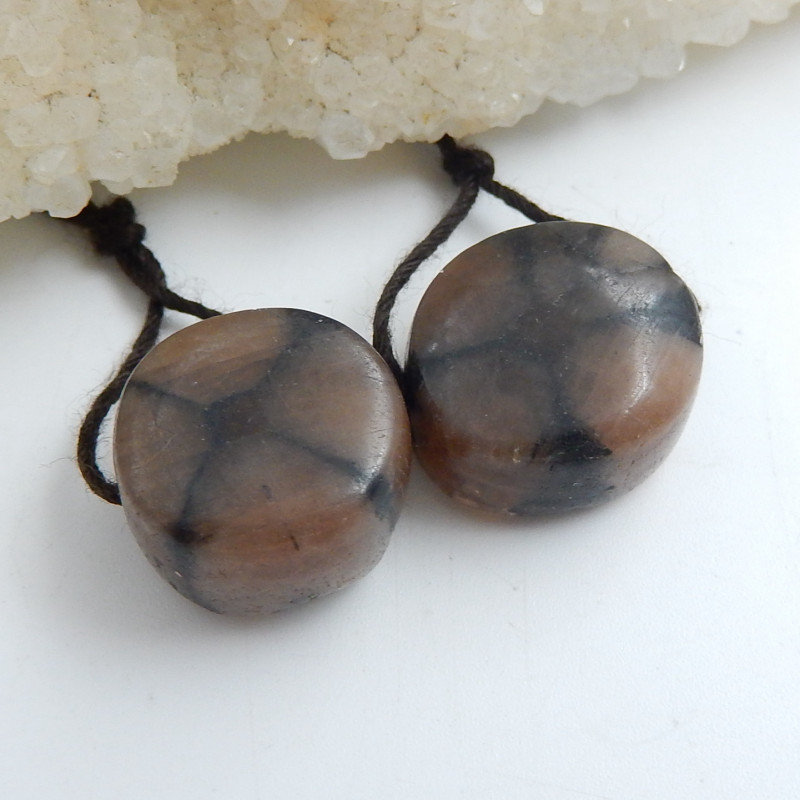Chiastolite Gemstone: Properties, Meanings, Value & More
 Chiastolite (pronounced ky-AS-tuh-lyte) is a cream to brown andalusite gemstone with a black geometric cross pattern. Many call chiastolite the “cross stone.”
Chiastolite (pronounced ky-AS-tuh-lyte) is a cream to brown andalusite gemstone with a black geometric cross pattern. Many call chiastolite the “cross stone.”
Is chiastolite the same as andalusite? Sort of. Andalusite is its own mineral, but it also has two varieties: viridine and chiastolite. So, every chiastolite is andalusite, but not all andalusite stones are chiastolite.
Is chiastolite rare? Yes, very rare. Gem-quality andalusite stones are already rare, and chiastolite is an even rarer variety.
If you’re thinking of browsing some chiastolite for sale or just want to know more about the famous “cross stone,” follow along as we break down all of chiastolite’s properties, healing powers, meanings, and more!

About Chiastolite Stone
Chiastolite is usually an opaque, brown semi-precious gemstone used for adornment because of its cross pattern. Besides “cross stone,” chiastolite’s other names include:
Lapis crucifer
Lapis cruciatur
Macle
Maltesite
Crucite/crusite
Chyastolith
Additionally, sellers may label chiastolite as “trapiche andalusite.”
Trapiche gemstones have mostly symmetrical “spokes” of inclusions due to uncommon growth conditions, making them rare and sought after. The most prized are the trapiche emeralds from Columbia.
Astrologically, chiastolite zodiac stones grace Libra and Capricorn signs.
Industrially, andalusites like chiastolite are used in refractory linings for kilns and furnaces for their excellent heat-resistance.

Chiastolite Specifications & Characteristics
Chiastolite is a variety of andalusite, an aluminum silicate. The formula for chiastolite is Al2SiO5 or Al2(SiO4)O. Besides chiastolite, andalusite varieties also include viridine and andalusite itself.
Compared to the other varieties, chiastolite has a lower hardness and density. Most andalusites are 6.5-7.5 on the Mohs hardness scale with a density of 3.12-3.17. Chiastolite, however, ranks at 5-5.5 on the Mohs scale with a 3.00-3.15 density.
Additionally, andalusite is known for being strongly pleochroic. While most chiastolites won’t appear pleochroic, you can see pleochroism in thin, transparent to translucent slices.
Among trapiche gemstones, chiastolite is unique in not having high symmetry (it’s only pseudo-tetragonal). The gem is also unique in being able to form prismatic crystals with square cross-sections. It also forms euhedral crystals or grainy/radial aggregates.
Here are chiastolite’s mineral properties:
Mohs hardness: 5-5.5
Color: White, gray, yellowish, brown, green, brownish-pink, greenish-gray, brownish-gray; Black, gray, or green cross pattern
Crystal structure: Orthorhombic
Luster: Vitreous (glassy) to matte
Transparency: Translucent to opaque, rarely transparent
Refractive index: 1.62-1.64
Density: 3.00-3.15
Cleavage: Distinct, 1-direction on [110](?)
Fracture: Even to subconchoidal
Streak: White
Luminescence: Fluorescence sometimes present - Brown or yellowish-green in SW-UV
Pleochroism: Visible in thin slices or at core of transparent specimens, but usually unobservable

Chiastolite Meaning & History
Chiastolite symbolizes reinvigoration, change, and balance. It also represents protection and devotion. Its association with devotion, particularly in the spiritual sense, has spanned various cultures’ interpretations of chiastolite’s spiritual meaning over time.
Another mineral with similar folklore is staurolite, sharing the nickname of “fairy cross stone” with chiastolite. For centuries, folks collected these stones, believing their 4-way crosses held power.
Some ancient interpretations of the meaning behind chiastolite’s cross include being a sign from deities, a good luck charm, and a protective talisman. They were often used for protection against the evil eye, sorcery, or misfortune.
Native Americans historically used chiastolite and staurolite for protection during rituals. One Cherokee tribe even incorporated legends of the Yunwi Tsunsdi, or “Little People,” whose tears were cross-shaped.
However, chiastolite’s predominant interpretation throughout history became associated with the cross of Christianity.
Early History
The name “chiastolite” comes from the Greek chiastos, meaning “cruciform” or “arranged diagonally,” after the Greek letter chi’s resemblance to “X.”
The first record of chiastolite was a drawing in De Gemmis et Lapidibus (Latin for Of Gems and Stones), a 1648 book by Dutch geographer Johannes De Laet.
However, the first official description came from Spanish missionary and paleontologist, José Torrubia in 1754, published in his book Aparato para la Historia Natural Española (Spanish for Apparatus for Spanish Natural History).
Coincidentally, Torrubia’s description came before andalusite’s first description by French mineralogist Jean-Claude Delamétherie in 1798.
Starting in the 1500s, chiastolite became most prominently sold as a religious souvenir to those completing the Camino de Santiago (“Way of Saint James”) pilgrimage in Spain. This Christian pilgrimage to Santiago de Compostela, a cathedral over the apostle St. James’s tomb, began in the 9th century.
This holy site, the final destination of a 1,000-km journey, is one of the three places Catholics can travel to absolve them of their sins, along with Jerusalem and Rome.
Significance in New England
Across the pond, European Separatist colonists settled in Massachusetts, USA, in 1620 and 1653. Both the 1620 pilgrims and the 1653 Puritans groups were largely Christian.
In present-day Lancaster, Massachusetts, the colonists found chiastolite and became enamored by its mysterious, possibly sacred formation. They sent chiastolite stones back to England, where it became popular amongst royals and remains in many English museums. The colonists also used it for adornments like buttons and studs.
Modern Significance
Today, chiastolite remains an important cultural item in Spain and France, where it’s mined and still sold to Catholic tourists, often polished and mounted into chiastolite jewelry.
A detailed account of chiastolite’s local significance in Spain is M. Calvo Rebollar’s 2016 study, “El "lapis crucifer", "piedra de cruz de Compostela": un elemento importante de los patrimonios geológico y cultural del NW de España” (Spanish for “The "lapis crucifer", "stone of the cross of Compostela": an important element of the geological and cultural heritage of NW Spain”).
Besides religious souvenirs, what is chiastolite used for? Healing, of course!

Chiastolite Healing Properties
The color and vibrations of all gemstones make them useful as healing stones. The common brown and black colors seen in chiastolite means this stone joins other black and brown gemstones in providing grounding, protection, and connection to nature.
However, many chiastolites have a creamy white base color, so these evoke the purifying and transformative properties of white gemstones. Additionally, gray chiastolites represent the balance and harmony of gray crystals.
What about chiastolite stone benefits for physical, emotional, and spiritual healing?
Physical Healing
Physically, chiastolite is said to help treat:
Gout
Improper blood circulation
Nerve damage
Stroke victims
Muscle weakness
Low blood pressure
Rheumatism
Paralysis
Onto emotional healing!
Emotional Healing
Chiastolite’s symbolism in rebirth and rejuvenation can make it a helpful companion during significant transitions. Its purported ability to increase resilience and determination, along with being soothing, makes it extra helpful during changes.
Additionally, this crystal’s protective properties against negativity are said to provide you with greater inner peace, positivity, and problem-solving. Crystal healers often recommend chiastolite for those working on personal growth.
Chakra Healing
Chakra healing involves opening a blocked chakra (energy center along your body) to resolve negative symptoms. What chakra is chiastolite for? Chiastolite is a chakra stone for the root chakra.
The root (base) chakra governs fundamental needs for safety and connection. Using a chiastolite chakra stone, you can change blockage symptoms of insecurity and isolation into balanced symptoms of feeling confident and connected.

Chiastolite Gemstone Properties
When determining chiastolite’s objective value, the most important gemstone properties to consider are its color, cut, clarity, transparency, and treatments.
Color
The most common coloring for chiastolite is a brown base and black cross pattern. However, the body color may also be cream, pinkish, greenish-gray, gray, or reddish. Light to dark green chiastolite is especially sought-after.
The cross pattern is composed of tubes, sometimes straight with wavy surfaces. Because the crystal’s prism faces grew quickly, the carbon or graphite inclusions got pushed out toward the crystal’s edges. Sometimes, chiastolite can display yellow and brown colors in a wavy, alternating pattern.
Many sellers consider pale pinkish-brown coloring the best.
Cut
Chiastolite is rarely, if ever, faceted. Most often, it’s cut as cabochons, beads, tumbled stones, or polished slices. Since every chiastolite is different, these make one-of-a-kind jewelry pieces.
Sometimes, you’ll see a chiastolite sphere cut by a skilled lapidarist (gem-cutter). It may also be carved.

Clarity
As you know, chiastolite’s distinct appearance is due to carbonaceous inclusions, specifically graphite particles, forming geometric shapes. (Yep, the same graphite used in pencils!)
This is unsurprising, as andalusites have a Type II colored gemstone clarity grade, so some visible inclusions are common.
However, chiastolite’s inclusions differ from other andalusite varieties in increasing its value. The only downside is that the inclusions decrease chiastolite’s hardness and durability.
Transparency
Because most chiastolite stones are opaque, the rare transparent to translucent specimens are significantly more valuable. Most chiastolite gems have greater translucence when sliced and polished.
Treatments
Though it’s not common, andalusite specimens (including chiastolite) have been heat-treated and/or fracture-filled with resin. Though heating doesn’t change the color much, fracture-filling can increase durability and clarity.
Next, how does chiastolite form?

Chiastolite Formation & Sources
In general, trapiche minerals like chiastolite are somewhat of a recent discovery, and their formation isn’t fully agreed upon by researchers. However, the most widely accepted theory came from American mineralogist Dr. Clifford Frondel in 1934.
Frondel’s theory is that chiastolite’s “cross” forms via different growth rates. As the stone forms inside rocks going through metamorphism, the crystal’s growth rate decreases where the graphite impurities become more heavily concentrated.
The graphite or carbonaceous impurities become acicular (needle-like) crystals that clump together around “re-entrant” angles, or indentations usually indicative of twinned crystals meeting.
Almost all chiastolite minerals are found in metamorphic rocks or metamorphosed sediments rich in graphite. Some chiastolite crystals become altered by paragonite, muscovite, and margarite.
Where is chiastolite found, though?
Mining Locations
Today, China’s Hunan Province produces the biggest chiastolite crystals, but Spain has the most abundant deposits.
South Australia is significant for its unique black chiastolites with green cross patterns. Brazil is also important for producing some transparent chiastolite stones with pinkish-brown to brownish-pink coloring.
Other sources of chiastolite include:
Brazil
Canada
Chile
France
Korea
Myanmar
Russia
Sri Lanka
UK (England, Scotland)
USA (California, Delaware, Massachusetts, Nevada)
Chiastolite from France are exceptional, growing in relative abundance and forming large, well-formed crystals or translucent, pink crystals.

Chiastolite Price & Value
As we mentioned, some sellers may label chiastolite as “trapiche andalusite,” so keep that in mind when shopping.
Price-wise, chiastolite cabochons and tumbled stones cost $5 to $30 at wholesale. Rough specimens are generally $30 to $35 for parcels weighing 1670 to 1930 carats.
Chiastolite carvings like skulls are generally $50 to $65, while chiastolite spheres range from $15 to $130, mostly depending on size.
Plenty of chiastolite jewelry pieces are available, though rings and pendants are most popular. The jewelry price ranges are:
Pendants: $4 to $200 (with silver settings & no other gems incorporated) at retail; $6 to $20 at wholesale
Rings: $5 to $200 (with silver settings & no other gems incorporated)
Earrings: $10 to $130
Beaded Bracelets: $20 to $100
Cufflinks: $20 to $90
Before we wrap up, you’ll want to know how to care for your gemstone.
Chiastolite Care and Maintenance
Given its relative softness and cleavage, we recommend getting chiastolite jewelry with protective settings.
You can safely clean chiastolite with a soft toothbrush dipped in a mild soap and warm water mixture. Keep it away from extreme heat and harder gemstones.

Feel the Harmony & Protection of Chiastolite!
Cross stone, fairy cross stone, trapiche andalusite — whatever you call it, chiastolite is a gem worthy of showing off, be it in jewelry or a collection. It’s perfect for collectors, history buffs, and unique-gem seekers alike!
Though some consider it more of a curiosity mineral than a gem, that only highlights chiastolite’s versatility. It often displays warm autumn hues, but its diverse color range is perfect for any earthy style year-round.
Was this article helpful?
Ross Sedawie
- Written - 24th Jul 2022
- Edited - 1st Aug 2023












